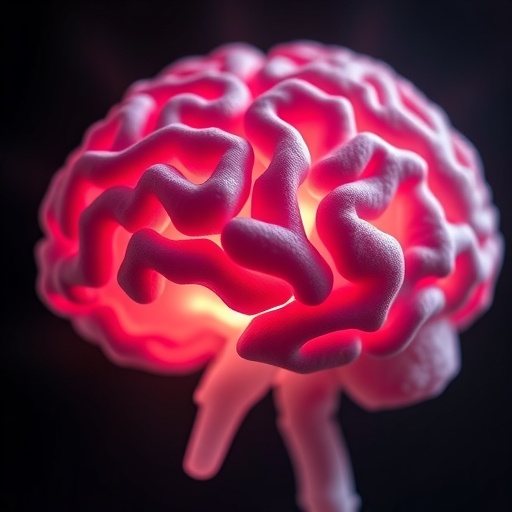In a groundbreaking study, researchers have delved deeply into the molecular intricacies that dictate early human brain organoid development, unraveling how the extracellular environment critically shapes neural identity and patterning. By employing advanced single-cell transcriptomics, the team dissected the gene expression landscapes of organoids cultured under varying matrix conditions, shedding light on how different physical scaffolds impact the emergence and differentiation of neural lineages.
The investigators cultured brain organoids within three distinct extracellular matrix environments: the widely used Matrigel, agarose, and a no-matrix condition to define baseline characteristics. At day 13 of development, these organoids were subjected to single-cell RNA sequencing to capture the heterogeneity and transcriptional states of individual cells. This approach allowed the researchers to map how the matrix milieu influences cell fate decisions at remarkable granularity.
Their analyses uncovered a multitude of neural progenitor populations, ranging from telencephalic to non-telencephalic lineages. Notably, organoids embedded in Matrigel exhibited a pronounced enrichment for telencephalic progenitors—precursors to the cerebral cortex—while those grown either in agarose or without any matrix showed a relative increase in neural crest cells, which give rise to peripheral nervous system components. This distinction was statistically significant, suggesting that the extracellular matrix provides essential cues guiding regional neural identity.
Functional enrichment and Gene Ontology annotations of genes differentially expressed between the Matrigel and no-matrix groups revealed a fascinating network of signaling pathways modulated by matrix presence. Pathways such as WNT, Notch, FGF, and Hippo signaling emerged prominently, emphasizing their crucial roles in neural fate specification and organoid morphogenesis. In conjunction, genes involved in remodeling the actin cytoskeleton stood out, hinting at underlying changes to cell shape and motility imparted by matrix interactions.
Of particular interest was the observation that transcription factors canonically linked to rostral neural tube and forebrain patterning—including SIX3, LHX2, NRG1, FOXH1, and HESX1—were more highly expressed in Matrigel-embedded organoids. These transcriptional signatures reinforce the concept that the microenvironment can bias progenitor pools toward specific brain regional identities. Such patterning parallels developmental axes observed in vivo, underscoring the physiological relevance of matrix-dependent regulation.
Conversely, organoids cultured without extrinsic matrix upregulated a distinct cadre of genes associated with the WNT–β-catenin signaling cascade, including WLS, RSPO3, and GPC3. WLS, a known early marker of non-telencephalic fate, displayed robust elevation under no-matrix conditions, hinting at a heightened WNT activity that may redirect differentiation trajectories away from dorsal forebrain lineages. This molecular signature aligns with in vivo data, as these WNT-related genes are highly expressed in non-telencephalic cells within the developing human brain.
Validating these transcriptomic insights, complementary techniques such as whole-mount hybridization chain reaction (HCR) staining and multiplex immunohistochemistry using iterative indirect immunofluorescence imaging (4i) corroborated differential expression patterns of key marker genes like WLS, SFRP2, NPTX1, PRTG, PODXL, RAX, PAX6, and SOX10 between the Matrigel and no-matrix groups. These confirmatory experiments lend robustness to the dataset and extend the findings into spatial and protein-level contexts.
Together, the results establish a compelling paradigm: the extracellular matrix is not merely a passive scaffold but an active determinant of dorsoventral and rostrocaudal patterning within brain organoids. By modulating pathways such as WNT signaling, matrix components orchestrate the emergence of region-specific neural progenitors, influencing the architectural and functional maturation of these miniature brains.
This study holds profound implications for developmental neuroscience and regenerative medicine. It underscores the necessity of carefully tailoring matrix environments to guide organoid differentiation faithfully, potentially improving disease modeling and therapeutic screening platforms. Moreover, understanding how matrix composition tunes signaling pathways opens avenues for engineering organoids with greater complexity and reproducibility.
In addition, these insights may extend to in vivo brain development, where extracellular matrices dynamically shape neural progenitor niches. Dissecting these interactions at the molecular level could illuminate mechanisms underlying neurodevelopmental disorders linked to aberrant progenitor patterning.
The integration of high-dimensional single-cell transcriptomics with advanced imaging techniques exemplifies the power of multimodal approaches in uncovering the morphodynamics of early human brain formation. The fine-scale resolution achieved here captures nuances of progenitor state transitions influenced by microenvironmental factors, a critical step toward recapitulating human neurodevelopment in vitro.
Future research building on these findings may explore how modifying specific matrix components could steer organoid development toward desired brain regions or cell types. Combining this with gene editing and temporal control of signaling cues could yield unprecedented organoid models to probe neurodevelopmental processes and pathologies.
In conclusion, this pioneering work elucidates how the extracellular matrix sculpts the early developmental trajectories of human brain organoids through modulation of key signaling networks. Such foundational knowledge is instrumental for optimizing organoid culture systems, broadening their utility in basic biology and translational applications, and ultimately forging new frontiers in understanding the human brain.
Subject of Research: Early developmental patterning and molecular signaling in human brain organoids influenced by extracellular matrix conditions.
Article Title: Morphodynamics of human early brain organoid development
Article References:
Jain, A., Gut, G., Sanchis-Calleja, F. et al. Morphodynamics of human early brain organoid development. Nature (2025). https://doi.org/10.1038/s41586-025-09151-3
Image Credits: AI Generated




